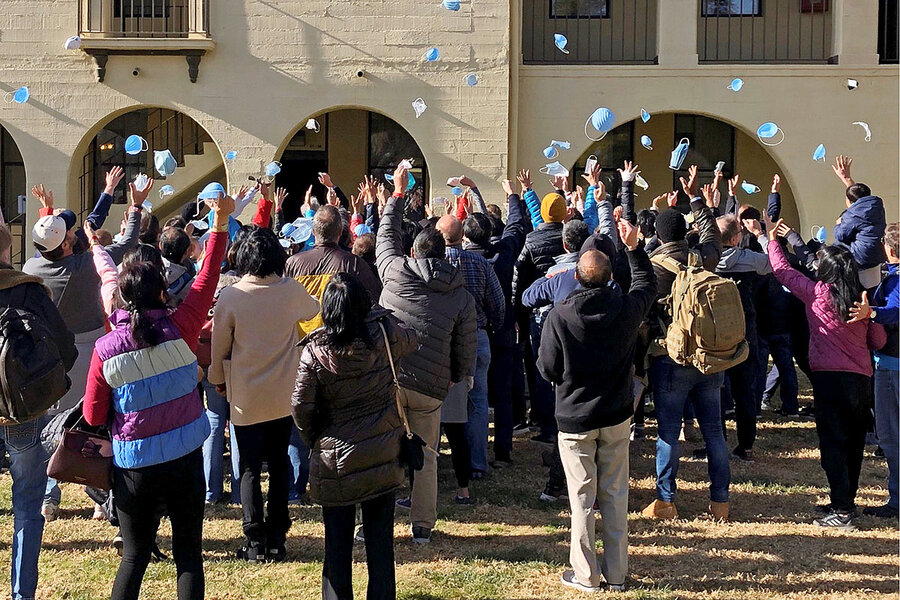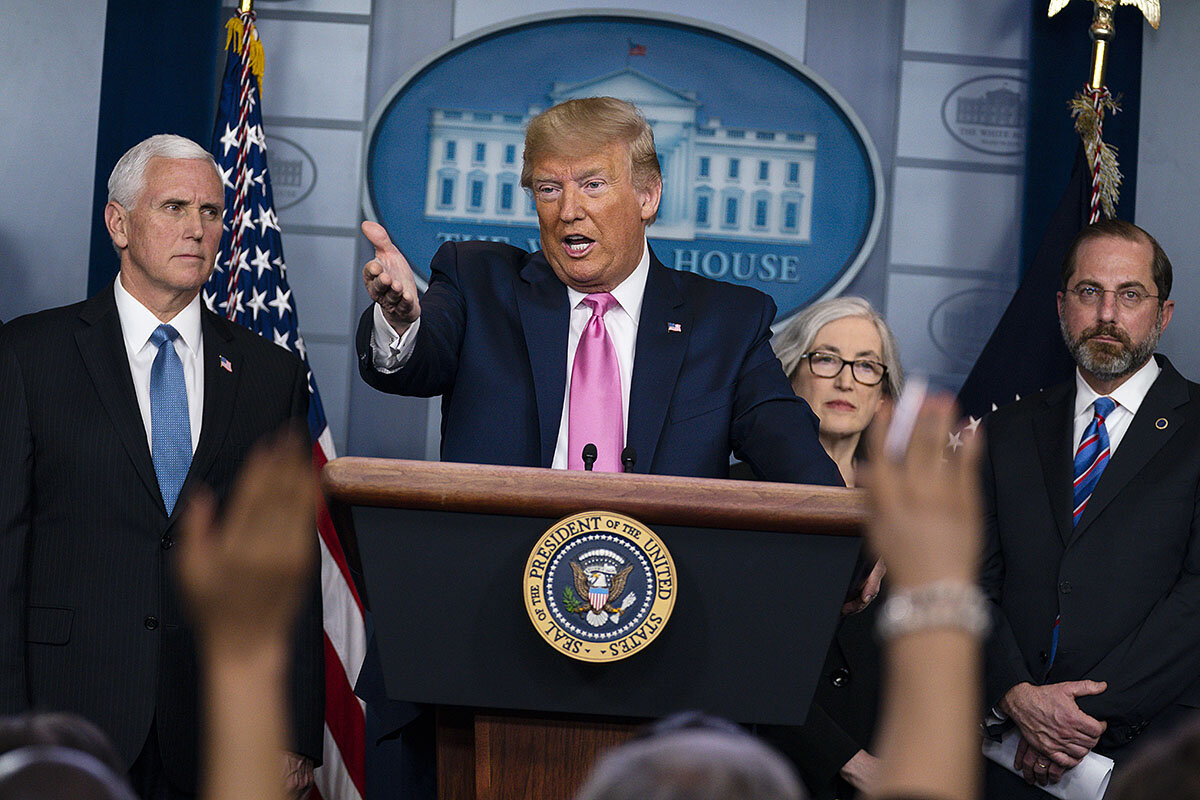Coronavirus puts health officials on messaging tightrope
Loading...
| Pasadena, Calif.
After health officials in California’s Orange County announced that a patient was diagnosed with the new coronavirus on Jan. 25, social media lit up with speculation about whether the patient was connected with Irvine Valley College, in the heart of the county.
Cindy Vyskocil, the acting president of the college, got on the phone with the county health office. No, there was no known exposure at the college. If there had been, the office would have contacted her immediately. Risk of exposure in the county was low. Relieved, she sent out an account to the college community.
Twice a day she talked with health officials. Twice a day she updated everyone associated with the college, including with information about precautionary steps that individuals should take and that her administration was taking. Despite the communication early and often, she took calls from parents wanting to pull their children from the college, which has a lot of international students.
Why We Wrote This
If you want to fight a public health crisis, you need one thing in abundance: calm. But how do you keep fears at bay in a world saturated with social media?
“I kept coming back to, ‘Irvine is a safe campus and we are open for classes ... but also wanting everyone to take precautions,’” she says. It’s a fine line to walk between preventing panic and being honest even with information that may be troubling. “It’s not easy at all,” she says, especially in the age of social media.
The story of the new coronavirus is unfolding in a world saturated with social media. This presents many more opportunities for misinformation, from willful distortion to well-intended ignorance. It also presents a challenge to health officials and others who deal with the public, especially when many questions about the coronavirus remain unanswered.
“This is the first social media pandemic, and that changes everything,” says Carl Bergstrom, a biologist at the University of Washington in Seattle who also researches misinformation.
A virus ... and viral information
People are watching the spread of the virus in “real time,” and instead of it being reported out by the scientific community, many other actors are involved, Professor Bergstrom says.
Those include people sharing what they hear, whether it’s reliable or not; “snake-oil salesmen” peddling their particular tonic; domestic and international opponents of China, where the outbreak started; people using the virus to promote isolationism and discrimination; and those engaging in the same kind of “information warfare” used in the 2016 U.S. elections to now undermine trust in governments, nongovernmental organizations, and the media.
“It’s a complex ecosystem, with a lot of different actors, with a lot of different motives, pumping information in,” Professor Bergstrom says.
Unknowns about the COVID-19 virus, as it has been termed by scientists, add to the confusion, he and others say. Now, for instance, the 14-day quarantine period is being questioned, and scientists and the medical community have a hard time evaluating the virus when they don’t know how many people in China were infected. Meanwhile, what the medical and scientific community does know is changing on a daily basis.
So far, the World Health Organization reports 82,539 confirmed cases in 47 countries, with 2,812 deaths. The Standard & Poor’s 500 stock index has fallen 10% in just six days, driven by rising concerns about the virus. On Thursday, the sell-off in global markets was accompanied by Japan’s prime minister calling for the nation’s schools to close during the next month as a precaution.
The Centers for Disease Control and Prevention (CDC) underscored the uncertainty this week. On one hand, it warned that it’s not a question of if the virus will spread in the United States, but when, given the spread in the rest of the world. American hospitals, schools, and businesses should prepare “in the expectation that this could be bad,” said the CDC’s Dr. Nancy Messonnier, director of the National Center for Immunization and Respiratory Diseases.
But the agency also can’t say whether the impact will be weak or severe, or when a wider transmission of the disease might occur.
The sharp warning, despite its vagueness about severity, stood in sharp contrast to the relative calm expressed by President Donald Trump, who on Wednesday appointed Vice President Mike Pence to oversee the federal government’s response to COVID-19.
Emily Blodget, an expert on infectious diseases at the Keck School of Medicine at the University of Southern California in Los Angeles, says she is surprised by the CDC’s “somewhat alarmist” approach, especially given the small number of cases in the U.S. “The way they framed it, it made it sound quite dramatic.”
There are only 14 confirmed cases in the U.S. as of Feb. 26, according to the CDC, plus 45 cases among people repatriated from Wuhan, China, and a Diamond Princess Cruise ship. On Wednesday, the CDC announced another case in northern California, this time apparently not related to travel or contact with anyone known to have the virus.
Still, Dr. Blodget says the CDC is “approaching it the right way,” because “they don’t want to be responsible for creating a big epidemic in the country” by underplaying the situation.
Not a “pandemic” yet, officials say
“Unfortunately, science is messy,” with conflicting reports and many unknowns, says Barbara Ferrer, director of public health for Los Angeles County, the largest county in the country and a gateway to the U.S. from Asia.
And the language of science can be alarming or misleading to those who don’t work with it every day. “Pandemic,” for instance, means a disease that spreads quickly over a wide region or the world – but it does not indicate severity. “Virulence” indicates severity, but not spread. And “quarantine” refers to the isolation of someone who has been exposed to the virus but is not ill.
While the World Health Organization has declared a “public health emergency of international concern” – its highest level of alarm – it has not yet declared the new coronavirus a pandemic.
“Using the word ‘pandemic’ carelessly has no tangible benefit, but it does have significant risk in terms of amplifying unnecessary and unjustified fear and stigma, and paralyzing systems. It may also signal that we can no longer contain the virus, which is not true. We are in a fight that can be won if we do the right things,” said Dr. Tedros Adhanom Ghebreyesus, the World Health Organization’s director-general, at a briefing on Wednesday.
Public officials, including the CDC and the Trump administration, need to coordinate their message, health experts say. They need to direct the public to official websites, including those of state and local health departments, and make their most urgent information easily visible and accessible.
“You don’t want to create panic, but you don’t want to make false assurances, either,” Professor Bergstrom says. “It undermines trust if you say it’s all taken care of, and you end up wrong.”
Telling people not to be scared, when they fear a new global virus that has no specific treatment or vaccination, is counterproductive, says Dr. Ferrer. “Better to say to folks, ‘We understand you’re scared; here’s some things you can do to protect yourself. Here’s my promise to you: As soon as I have good information, I get it to you. I don’t hold onto it.’”
Dr. Ferrer’s office had to firmly put down a hoax that falsely claimed on fake letterhead five cases in a majority-Asian community. She says she’s taking a “multipronged” approach to messaging, including almost daily updates to its website, teleconferences with the media and officials, and bringing thousands of information packets to trusted community organizations and businesses.
Long before the CDC made its announcement this week, Dr. Ferrer says the county has been preparing for widespread transmission and how that might affect people’s mobility, including school and office closures. “It’s similar to being prepared for earthquakes, fires, or bad weather. I think preparedness is the name of the game for everybody.”







